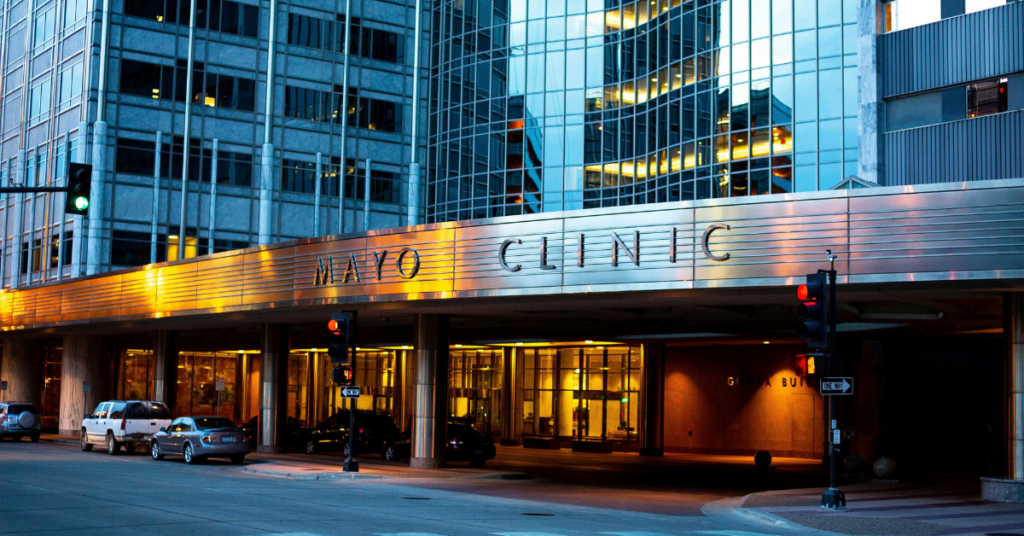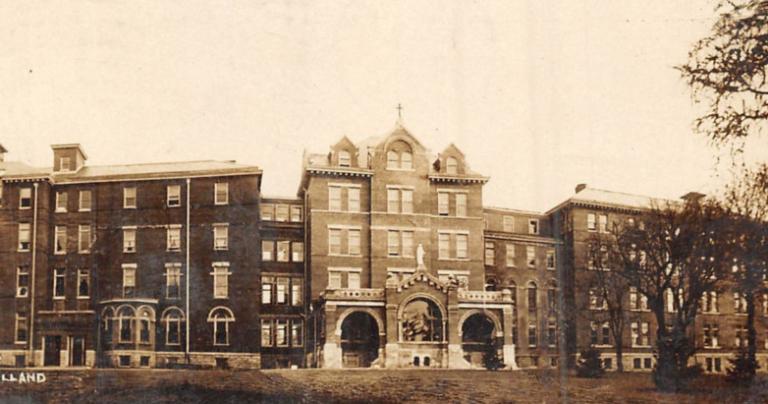I’ve previously written about my experiences with monasticism, specifically as experienced in the quiet halls of St. Augustine’s House, a Lutheran Benedictine Monastery in Oxford, Michigan. I currently serve as a chaplain resident at the bustling Mayo Clinic, a world renowned hospital in Rochester, Minnesota. Though the two spaces could hardly differ more in pace, the time I spent learning about the monastic tradition and vocation at St. Augustine’s House has profoundly shaped how I approach my role here at Mayo, and I’ve discovered that Mayo’s overall existence is inextricably tied to the work of a monastic community.
St. Mary’s Hospital was founded in 1889 through a collaboration between members of the Mayo family and the Sisters of Saint Francis. Mother Mary Alfred Moes led the sisters at the time of the hospital’s founding, and since then, the sisters have served as nurses, spiritual care providers, greeters, and much more. They have served as the backbone of the now world-class medical facility since its very beginning. This rich history is reflected through the buildings named after members of the community, pictures of the sisters on the walls, the continued presence of the sisters today, and many of Mayo Clinic’s rich traditions.
I stepped into this legacy of monastic faithfulness and service when I began my residency. Being surrounded by the reminders of a monastic heritage in my daily work often causes me to think about my own connections to Saint Augustine’s House, and the impact it has on my life and work. Three especially poignant connections for me have been the presence of God in vocation, the power of being present, and the role of silence.
God in vocation
At the hospital, I have the opportunity to work alongside professionals from a vast expanse of professions. I don’t think I could even name every field of work with which I’ve engaged so far. As I continue my work, I discover more and more people with unique careers and skills that are a part of the network of care. As a chaplain, I hear about and see God at work all the time through those who have come together to facilitate care and healing for people in need. Especially when I take time to step back and reflect, I see the ways in which I believe the many members of the care teams are living into their vocations to facilitate healing in powerful ways.
When I spend intentional time in reflection following profound encounters with patients and their families on the ways they see God at work around them, I draw my mind back to Saint Augustine’s House. In one of my visits, a conversation with one of the brothers helped me to think about one of the roles of the monastic vocation. He spoke of a monastery as a place that points to God through its rituals, active centering on prayer, even the very presence of the monks. The daily lives of the monks help them, and their guests, to really feel and experience the presence of God in a profound way. The monastic environment makes focusing on this presence easy. The buzz of the hospital does not produce the same environment. However, that doesn’t mean that I can’t see and feel God at work in it. The following is an excerpt from a reflection I wrote during an overnight shift when I took a moment to reflect on God’s work through it all:
As I walk the halls, there’s a buzz about this place. A buzz of life and healing. A buzz of care. A buzz of people. Patients, laying asleep or sleepless, in bed. Patients on walks with staff, or talking with people on the phone. Staff, bouncing room to room already looking worn out … and in the midst of this, I have the hallowed duty to walk these halls. These are halls that have been walked for over a hundred years by sisters of St. Francis, caring for patients. And now, now I am a part of this mission, this sacred calling. I am the one who walks the halls tonight.
The power of presence
Life at the monastery operates at a different speed than life in the world. The juxtaposition between the two can feel quite jarring. Life at the monastery is organized around praying the daily office, and everything else fits between the times of prayer that structure each day. I wake up and go to bed significantly earlier when I’m there. Stepping into this very different routine, nonetheless quickly becomes comfortable, and I find myself feeling more present with those whose routine I have joined. This often leads to opportunities for connection, self reflection, and grounding.
In the hospital, patients and their families are thrust into a new environment, one in which the routines are typically vastly different from their norms. In many cases, they have to adjust to medical team members rotating in and out of their rooms constantly throughout the day. When I have the opportunity to step into their space, I remember both the discordant nature of an altered routine, and the power of being present in one’s midst. This leads me to both readily acknowledge with people how hard hospitalization itself can be, while doing my best to actually sit with them, where they are. Often visits don’t last long–certainly not as long as my visits to the monastery, but I do hope to offer a short experience of someone being present with them, no matter where they find themselves emotionally, spiritually, or physically at the time of the visit. I continue to explore what this looks like every day, and the legacy of the sisters of St. Francis is a constant reminder of those who have, and continue to be, present for those in search of healing.
The power of presence can also remind us of the fact that the people we care for each day are people. The importance of this seemingly simple statement is well-reflected in the following quote from one of the sisters:
“May you always see in your patient not an interesting or uninteresting ‘case,’ but a human being, a Child of God, whom you are privileged to serve, and through whom you may serve, the Divine Physician who is also the Prince of Peace.” –Sister Generose Gervais
Silence
If you’ve ever had the opportunity to visit a monastic community, perhaps naming silence as important seems self-evident. Silence is often an extremely important part of monastic life. It is a time for prayer, for sitting with oneself, reflection, and whatever else it may become for someone. In a world where we are so connected through technology, really stepping back and taking time for silence doesn’t typically come easy for people. What I have discovered through my years of engagement with Saint Augustine’s House is the centering and reorienting power of silence in my own life. In my own life, this could be silence for prayer, for calming my mind, for bringing attention to God, or for just being.
In the hospital, it often feels as though there is even less silence than the rest of the “normal world.” Machines are beeping, pagers are calling me and my colleagues to important work, people are talking, laughing, crying, ambulance sirens are blaring, and carts and machines are rolling down the halls. It is very easy to get lost and caught up in the bustle that is all around me. It is also important that, when I am meeting people, I join them where they are, often in contrast to the busyness around them. When a staff member is having a bad day and feeling down, or a patient is groggy and drained, or a family is anxiously awaiting the return of their loved one from a critical procedure or test, their outward energy is rarely that of the active hospital around them. In order to better enter into all the varying spaces in ways that allow me to be present, I frequently utilize silence.
Silence in the hospital takes a vast array of forms, from something as brief as a short pause to recenter myself before entering a room, to a walk to one of the chapels where I can just sit and be. The power of silence to give life, introduced to me at the monastery, has transformed into a dynamic practice of silence in the hospital to care for myself so that I can care for others in turn.
The monastery and the hospital are each unique places in our world. Spaces that, upon entering, can be jarring in how the routines differ from a “normal day.” I believe it is deeply important not to just go through the motions in either place, but rather to step into the unique routines, pausing to notice and feel God at work all around. Each day, the monks and their guests experience God in powerful ways. Similarly, patients, families, and staff members often share the profound ways God is shaping their lives. I hope that I, and others, will remember to step into the routines of this hospital, meeting others where they are, noticing and feeling the hum of healing, the very presence of God, in these halls.



